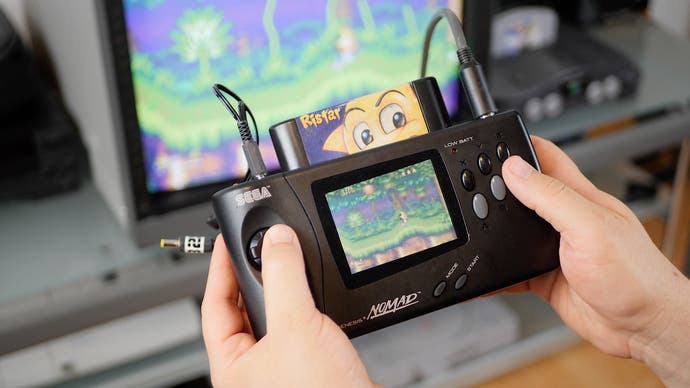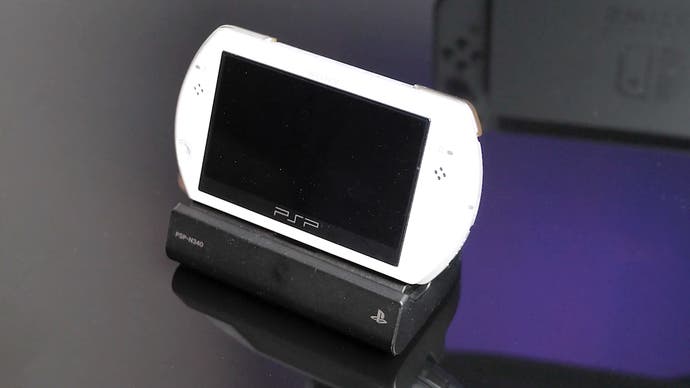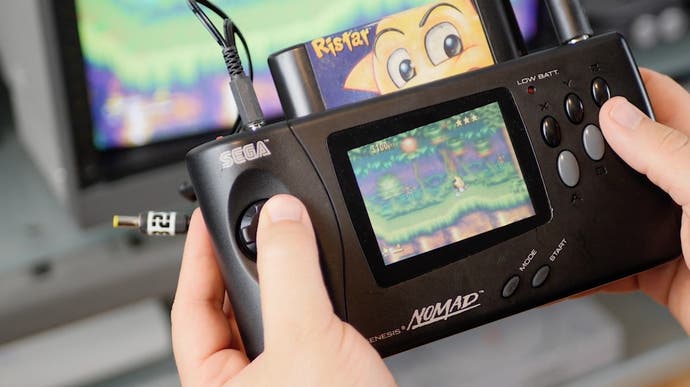DF Retro: Revisiting Sega's Nomad - the original Switch?
A handheld/home console hybrid... sound familiar?
What makes Switch so special is its enticing blend of portable and console gaming in a single device, but while Nintendo may be the first company to find real success with this idea, it certainly wasn't the first to try. Flash back to October 1995 and Sega released the Genesis Nomad - a handheld/home console hybrid with a remarkably similar feature set to the Switch. Mobile and big screen play? No problem. Support for multiple players? It's in there. As the Switch has proven, the basic console hybrid idea is brilliant, but as with many of Sega's early schemes, the Nomad didn't quite pan out.
First of all, it's worth pointing out that back in the 90s, 2D era consoles weren't anything like the power-hungry processing beasts we have on the market today, and as such, the Nomad certainly wasn't the first full-colour handheld based on a living room console - we can look to NEC's TurboExpress, 100 per cent compatible with the TurboGrafx 16/PC Engine, as a good example of this. Sega's GameGear - effectively a miniaturised Master System - is another prime candidate. However, none of these examples could also operate as a living room console in the way that Nomad and Switch can, and it's an important differentiation.
And what made the Nomad so cool at the time was that it really was the complete Mega Drive/Genesis package in a portable form factor, fully battery-operated and equipped with a 3.25-inch LCD screen and a built-in six-button controller. There was also nigh-on complete compatibility with support for standard cartridges - plugging in the 3D-accelerated Virtua Racing and playing it on the move is almost like a vision of the future to come (and no, 32X doesn't work - unless you want to mod the machine). And yes, a standard controller port is also included on the Nomad, allowing a second player to join in on the action.
Of course, in terms of basic functionality, while there's a great deal of commonality between the practical use-case scenarios of the Switch and the Nomad, the implementation is very different - a factor of both vision and technology. First of all, consider the portability aspect - both Switch and Nomad strive to offer gaming on the go with home console quality visuals for their respective generations.
Thanks to modern technology, the Switch features a relatively massive widescreen LCD display, a thin profile and a lightweight design. By comparison, the Nomad is bulkier, heavier and burdened by limitations of its day. Its 3.25-inch LCD screen, which was generously sized for 1995, is a passive-matrix LCD. This now-outdated technology exhibits slow response times and an inability to address singular pixels without influencing those around it. As a result, the screen exhibits severe ghosting and a fuzzy image. Worse still, the screen itself relies on a composite video line which further reduces picture quality. When you combine the severe ghosting with poor image quality, the Nomad really struggles with faster games like Thunder Force 4 or console flagship, Sonic the Hedgehog.
And when it comes to the portable experience, nothing is more important than battery life. The Switch includes an internal lithium ion rechargeable battery while the Nomad ships with a power pack designed to accept six AA batteries. Believe it or not, out-of-the-box battery life is reasonably comparable, but with Switch, you're not chewing through expensive batteries to keep it running. An optional rechargeable battery was released for the Nomad, allowing you to keep playing while charging just like the Switch - and over the years, battery mods have appeared for the Nomad enabling greatly enhanced battery life. Regardless, this is clearly and obviously the Nomad's greatest out-of-the-box weakness.
Beyond this, both systems feature a 3.5mm headphone output and built-in speakers but on the Nomad, this is limited to a low-quality mono speaker, so headphones are a must when played in portable mode. In terms of the portable experience, both systems get the job done but it's obvious that technological evolution allows the Switch to overcome the Nomad's weaknesses. These days, few people would bother with using a Nomad for its original purpose when there are so many easier ways to play Genesis games on the go but in 1995, it was really cool. Clearly, a high-end portable experience alone wasn't enough. So what's next?
Another major feature of the Switch is the option to enjoy single screen multiplayer games on the go without an additional television. Set the console down, grab some controllers and play away on the Switch's built-in LCD. The Nomad offers similar functionality by including a secondary controller port. With a Genesis pad connected, two players can team up on a single Nomad for multiplayer gaming. Unfortunately, this configuration doesn't work especially well. The Switch, with its wireless controllers, plastic kickstand and reasonably large screen, is adequate but with the Nomad, the player holding the unit will always have an advantage since the screen itself suffers from poor viewing angles. It's also nearly impossible to see the screen when outdoors, which isn't exactly helpful.
Lastly, there's the console experience - and this is ultimately what sets both the Nomad and Switch apart from the pack. The Switch is a capable machine delivering visuals exceeding Nintendo's previous generation console. Portability has an impact on its overall capabilities, of course, but it's reasonably competitive given its form factor. The Nomad, on the other hand, is a Sega Genesis/Mega Drive at its heart - a console which had been on the market since the late 80s. Despite this, Sega's 16-bit console still offered a presentation far exceeding any handheld before it. In 1995, the Genesis could conceivably have been compared to the Wii U in 2017 - both were somewhat outdated during these respective periods, but it was nonetheless amazing to see that level of visual quality in a mobile format.

Key to the experience on both machines is the inclusion of external display support, with the Switch using its supplied dock with HDMI output while the Nomad relies on a nine-pin connector capable of outputting crystal clear RGB video. Unlike the Switch, however, Sega made the mistake of not including video cables in the box - a misstep perhaps. Due to its short life, there's only one revision of the Nomad and its video output is pretty good. There exists a huge variation in video quality across the entire Mega Drive and Genesis line of consoles but the Nomad manages to stack up against the better units. 'Jail bars' - a common problem with certain revisions of the system in which visible vertical lines are visible in solid colours - are slightly visible but ultimately better than most other units. Audio is also of good quality. The included ASIC version of the YM3438 audio chip offers good sound when played through headphones or an AV cable- it's punchy and lacks the muffled output exhibited by certain revisions of the console.
Of course, when it comes to using each machine with a TV, the Switch concept offers a significant advantage in the form of its dock. Cable management is not required here beyond the initial setup - simply drop your Switch into its dock and it appears on your TV. You can then sit back and relax with a variety of different wireless controllers. With the Nomad, however, you'll need to directly connect the system to your television using a video cable and if you wish to save batteries, a separate AC adapter is a must - yes, remarkably, the Nomad didn't ship with a power supply. And even then, with everything connected, it's bulky and impractical. You'll need to sit relatively close to the screen and once again, two-player action is limited.
This is perhaps the area where the Nomad falls furthest - while it may be a portable Genesis at its heart, using it as a console isn't a great experience. The solution seems obvious in retrospect! Basically, if a second controller port were included along with an option to toggle between a controller and onboard controls, the Nomad could absolutely have matched a real console. It may have even been possible to include wireless controllers in the mix. While typically powered by infrared or radio frequency signals, wireless controllers did exist during this period - in fact, Sega itself released a set of IR pads for the Genesis that might have paired up nicely with the Nomad.
While much of the design seems a little half-baked - even by the standards of the time - the parallels between Nomad and Switch are undeniable. Both are fully self-contained units, capable of running on battery power for mobile gaming, along with the ability to seamlessly transition over to a living room TV. But the biggest difference is, of course, down to vision. The Nomad was a late entry in the lifespan of the Genesis/Mega Drive while Switch was built from the ground-up as a console hybrid, with a lot more thought put into the user experience. Sega's vision for the Nomad - such as it is - seems to be a case of simply creating the very best handheld it could produce at the time. It was a cool side-project, not the future of the business.

And perhaps it is that inherent coolness that means that the Nomad still gets a lot of attention today. The machine is highly moddable, with conversions allowing for the controller port to be used for single-player games and much more. Screen mods are also available that dramatically increase battery life for the machine. There's the sense here that it was left down to the most committed of users to improve the basic Nomad experience because fundamentally, the hardware just wasn't quite up to the task in 1995. In truth, just the lack of rechargeable batteries and an AC adaptor in the box was something of a deal breaker for users of the day.
In the wake of the Nomad, it took nearly a decade before another company would attempt to push the boundaries of handheld gaming again. In the following years, Nintendo would update its Game Boy line to include the Game Boy Color and the amazing Game Boy Advance but neither really pushed the limits of handheld technology at the time. The Neo Geo Pocket Color and Wonderswan also stuck with the formula of using cheap and simple components to keep the price down and battery life up. But in 2004, Sony launched with PlayStation Portable which did push the hardware envelope and managed to find reasonable success.
But here's the weird part: late in the system's life, a digital-only model known as the PSP Go was released. It was ridiculed at the time and failed hard, but it is remarkable in that it was first properly dockable handheld. You can drop the PSP Go into a dock, pair the system with a Dual Shock 3 and proceed to play games on your TV - very much like the Switch. The Go is basically a micro-console which plays both PSP games and PS1 games at a proper 240p, just like the real thing. While it lacks the multiplayer aspect and eliminated support for physical media, the docking system worked really well and it's a shame Sony didn't attempt to expand upon this with the Vita. I've always felt that this featured was hugely overlooked and with jailbroken firmware, the PSP Go is a great little travel console.
But as we've discovered, many of these 'portable plus' ideas stem from the Nomad. From hybrid consoles to motion controls all the way to online play and beyond, Sega certainly had a knack for introducing new features before the industry was truly ready for them. The Nomad is one of those products and exhibits the same faults - it works, but not quite well enough for the average consumer. Believe it or not, during its development, there were more ambitious and expensive plans in the works, including a potential touch screen, but ultimately the Nomad is what we received and what will go down in history as Sega's last major handheld console - and no, the Dreamcast VMU doesn't count.


